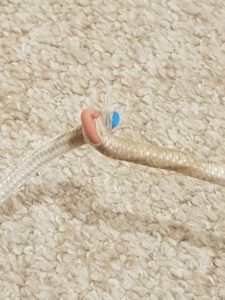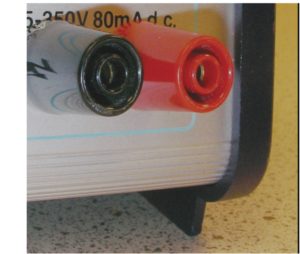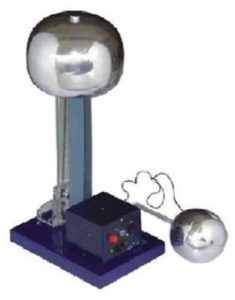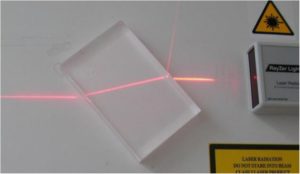1.1 Introduction
As with any activity, those involving physics apparatus must be risk assessed. Generic risk assessments may be used but it is vital that these are checked to ensure that they are suitable for the particular equipment and set of circumstances you fi nd yourself dealing with. If they are not suitable, they must be amended. Risk assessment is covered in a separate SSERC course. A blank risk assessment template and generic risk assessments can be found on the SSERC website: www.sserc.org.uk.
1.2 Electrical Safety – Portable Appliance Testing (PAT)
Portable electrical appliances must be inspected and tested regularly to ensure that they are properly maintained so as to prevent danger. The prime responsibility for this lies with employers and it is their duty to set up a routine inspection and maintenance programme as a recognised means of ensuring that appliances remain in a safe condition. In this context it is assumed that a portable appliance is:
- any appliance fitted with a plug top;
- any appliance capable of being readily disconnected from and reconnected to an electrical system;
- any appliance that requires a supply voltage in excess of 33 V ac rms or 70 V dc ripple free.
A sticker that claims that a piece of electrical equipment has been PAT tested only tells you that the equipment was satisfactory on the day of the test. It is rather like the MoT test for a car. An MoT certifi cate issued in June does not tell you much about the state of the tyres or brake pads in December. Whilst you should check that any portable electrical appliance you are issuing has indeed been tested, you should also conduct a quick visual test before, during and after use as follows:
- Check the supply cable throughout its length for signs of deterioration or damage;
- Check that the casing of the appliance is free from cracks;
- Check that the plug is free from cracks and that the outer insulation of the cable is firmly gripped by the cable clamps at both the plug and the appliance ends.

1.3 Power Supplies
The classification of power supplies used in education is shown below.
| Power supply type | Voltage output | Current output | Hazard |
| LT (Low Tension) | 25 V* maximum. | <9 A | Generally no risk of electric shock except in applications with inductors. Risk of burns or fire. |
| HT (High Tension) | Generally 400 V maximum. | Unlimited. Maximum values typically lie between 80 mA and 400 mA | Hazardous live.
Risk of electrocution. |
| EHT (Extra High Tension) | 5 kV | 5 mA absolute limit. Typical maxima are 2 mA or 3 mA.
|
Either outwith, or just inside, the hazardous live regime. Risk of harm is umlikely. |
| Table taken from SSERC Bulletin 208. Power supplies are classified by their electrical outputs and the hazards presented.
*For more information, please see the notes on Power Supplies.
|
|||
The only power supply type that clearly presents a risk of electrocution is the HT power supply. These have a limited application in physics and are used
chiefl y with the Teltron Fine Beam tube, the Teltron Critical Potentials tube and Neon lamp excitation.
If working with an HT supply, or indeed hazardous live in general, the following control measures should be taken, where appropriate:
1.3.1 HT Supplies – Engineering Controls
- Shrouded socket outlets on HT supplies;
- Shrouded terminals on apparatus (see picture);
- Enclosure of HT conductors in apparatus;
- Leads with shrouded connectors;
- Meters with minimalist features (Only 2 sockets and no current setting. Leads to GS38).
Administrative Controls
- Warning notice on HT power supply;
- Pupils under 16 years or S5 must not work with HT circuits;
- Instruction given to senior students on HT working arrangements;
- Warning notice placed beside HT circuit.

1.4 Transformer Experiments
Some activities in S4 and S5 physics involve pupils constructing transformers which can be used to step-up low voltages to higher ones. This usually involves using pairs of pre-wound transformer coils and harm can be avoided by following these rules:
- Use an ac power supply that is either designed or
locked to give no more than 2 V; - Give out coils such that it is impossible for pupils to use a pair of coils where one set has more than 12 times as many turns as the other. In other words, if the smallest coil has 60 turns, it’s OK for your largest coil to have 500 turns, but not 5000 turns. This is because the ratio of turns is the same as the ratio of voltages in a transformer.
1.5 Van De Graaff Generators
Although these devices seem to break the rules in that they can charge up to more than 100,000 V, we allow pupils to hold on to them and inevitably
some receive shocks.
Do not listen to anyone who says that charging pupils up using a Van De Graaff Generator is now banned, but the safety rules shown below should be followed.
If your department is considering buying a new machine, consult the SSERC website (or a SSERC physicist) first to make sure the one you buy conforms to our current guidelines.

The following rules should be applied:
- Before using a Van De Graaff generator teachers should check the appropriate school records for any relevant heart condition and should warn the class that it should not be used by anyone with such a heart condition;
- The dome should be discharged immediately after every operation ensuring that it never stands idle in a charged condition;
- The dome can be safely discharged by touching it with an earthed, metal conductor. The usual means is by a spark discharge to an earthed metal sphere mounted on a stand, or hand-held with a handle, which need not be insulated. If this is earthed, the operator does not receive a shock;
- The dome can also be safely discharged by touching it with a pointed metal wand which is earthed. The resulting corona discharge is accompanied by little or no sparking;
- The dome may be safely discharged through the human body by a corona discharge. With one hand fi rmly on the workbench, rapidly bring up an outstretched fi nger of the other hand to touch the charged dome. The shock is mild and not unpleasant. This is a safe way to discharge the dome. In contrast, were you to bring up a raised first to the dome, the machine discharges all its energy in one burst as a hurtful spark.
- The demonstration with hair standing on end may be done safely by adapting the above procedure. Begin with the generator off and dome uncharged.
The pupil should stand on an insulated platform (such as a plastic basin), placing one hand on the dome while ensuring that no part of the body or
clothing is in contact with the bench, or another person. Start the generator and run until hairs stand on end. Stop the generator and instruct the pupil to place his or her free hand on the benchtop while still keeping the other hand
fi rmly on the dome. Wait several seconds until completely discharged. Then tell the pupil to remove the hand from dome, step off the platform and walk away from the apparatus. The dome at this stage will not be carrying a charge
and will be safe for another person to touch;
- Persons being charged should be limited to volunteers;
- Pupils can be charged in a chain. The number needn’t be limited unless standing on insulated platforms, in which case no more than three;
- The demonstration of lighting a Bunsen fl ame by discharging through a human body via a pointed fi ngertip to the Bunsen funnel would seem also
to be fairly harmless. Being a corona discharge, the spark energy is low; - Because a human body has capacitance, do not let someone who has been in contact with a charged dome walk away without discharging. In these circumstances such a person may carry quite a lot of charge and experience a
disagreeable and possibly unexpected electric shock on touching earth. Any other persontouching such a charged person is also at risk of receiving a shock; - If the capacitance of the system were to be greatly increased, for instance by connecting the dome to a Leyden jar, the stored electric energy can increase dangerously. If it really is necessary to work with a Leyden jar then the person working with the apparatus must be a teacher who is competent to do the demonstration;
- Do bear in mind that any person getting a shock is at risk of harm from jerking or falling over in fright. There is then an indirect risk of a blow to the head, or damage to muscles, bones, or other parts;
- During spark discharges, electromagnetic energy is radiated from the spark gap. This radiated energy will be picked up by any nearby electrical
leads across which extra-high voltages can be induced. These voltages can destroy electronic apparatus. Vulnerable equipment includes anything supplied from a plug-top power supply such as a laptop computer, digital balance or digital camera because the long supply lead can act as an effective pick-up aerial. No such equipment should be within 2 m of a spark gap; - All science staff should be trained in how to work with the Van de Graaff generator and should be instructed to avoid a direct path through the human body to a good earth.
1.6 Lasers
Lasers are good light sources for use in schools. They produce beams that are bright enough to be seen even when the classroom lights are on.
- Pupils in S1 to S6 can use lasers, provided that the following guidelines are followed:
- All lasers are classifi ed. Do not use a laser that is more than class 2. The body’s natural aversion to bright light- closing eyes, turning away etc., is enough to protect you from damage from a Class 2 laser;
- Laser work should be supervised;
- If laser diode modules are used, they should be clamped, for example, in a boss head.
- Use beam stops to terminate the beam.

Laser Pointers
Battery powered laser pointers may seem like an inexpensive solution to laser optics but we feel that they are unsuitable for a number of reasons.
Firstly, they are likely to be unclassifi ed. Their performance varies hugely from unit to unit and is highly dependent on the batteries used. Our contact at the Health Protection Agency measured a batch of laser pointers and found that some didn’t work at all, whilst others were nine times more powerful than was suitable for schoolwork.
Laser pointers can also be picked up and waved around. Laser diode modules from a reputable supplier are much more satisfactory.
1.7 Mercury
Mercury is used in the Charles’ Law experiment in higher physics where a small thread is used to trap air in a capillary tube. These tubes are immersed in
very hot water and some teachers and technicians worry about mercury vapour being released as a result. However, SSERC has investigated this and
has been unable to detect any vaporisation of mercury from this activity.
1.8 Soldering
Soldering is only carried out on rare occasions in some schools whilst in others it is fairly routine. The following practices should be adopted:
- Use rosin-free solder (SSERC suggests using ECOSOL 105 from Multicore);
- Ensure that windows and doors are open to ventilate the workplace;
- Install LEV (local exhaust ventilation) if a lot of soldering is done. This is a legal requirement if rosin-based solders are used;
- Clean worktop surfaces, at least, at the end of each lesson by:
(1) sweeping debris into a dustpan, and
(2) wiping clean with a damp disposable towel.
Hands should then be washed and clothes brushed.
1.9 Working With Radioactive Sources
This is an introductory course and does not cover working with radioactive sources.
Working with Radioactive Sources is a course in its own right but this should not put you off from learning how to use them safely. The procedures to follow are straightforward and the little effort is more than outweighed by the benefit to the pupils from seeing real practical work carried out in this fascinating field.

